Scan Reveals Mummy Hidden in A 1000-Year-Old Buddha Statue
Whenever one sees the Buddha statue, it’s an instant reminder of Gautama Buddha’s teachings and travels. Besides that, the common postures, poses, and physical attributes that define its meaning and purpose also add to the uniqueness of this statue.
But that’s all there is to it, right? We believe that’s precisely what some researchers carrying out routine restoration thought until they discovered a 1000-year-old surprise waiting for them in a gold-plated Chinese Buddha statue.
It's a Mummy!
By mummy, we don’t mean someone’s mom. Instead, we’re talking about a preserved human body! According to findings, the mummified remains were that of a monk who lived in the statue.
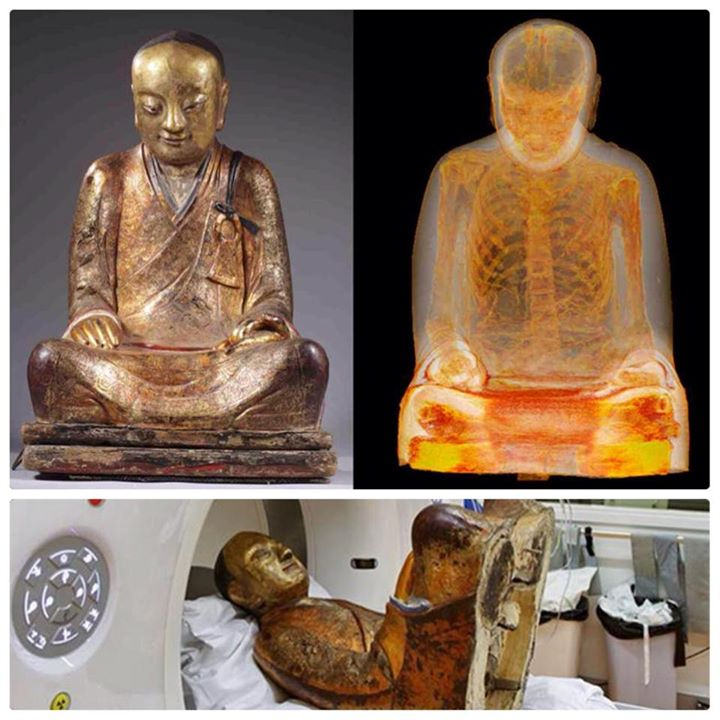
Source: The Emerging India
The golden-plated statue dates back to the 11th or 12th century. It was also revealed that the mummified monk was alive almost 1000 years ago. Now, how’s that for a surprise?
Put a Name to It
A Buddhist expert, Erik Bruijn, decided that it’ll be a wise idea to put a name to this discovery. So, he led a study that revealed its identity as a Liuquan, a Buddhist master. Liuquan was believed to have been a member of the Chinese Meditation School.

Source: b60/ YouTube
According to Vincent van Vilsteren, an archaeology curator at the Drents Museum in the Netherlands, the Buddhist monk must have been a respected one. In his opinion, Buddhists must have also worshiped him as an enlightened one, who ended the living’s cycle of suffering and death.
The First Discovery
As we mentioned already, the gold-painted Buddha statue’s secret was first discovered by researchers (preservationists) who needed to restore the statue many years ago. However, the mummy didn’t undergo extensive study until late 2021 when researchers took scans and tissue samples of the human remains.
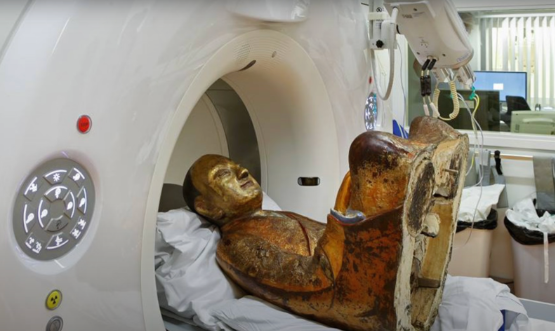
Source: b60/ YouTube
CT scans are just one of the many ways forensic scientists identify human remains. For intact body parts, X-rays, fingerprint identification, and dental examination are efficient methods.
A Murky History
The Buddha statue is a paper-mâché with a seated person’s dimensions. Covered in gold paint and lacquer, this statue has a mysterious history. It is believed that it was housed in a Southern Eastern Chinese monastery for centuries before the Cultural Revolution around 1966.
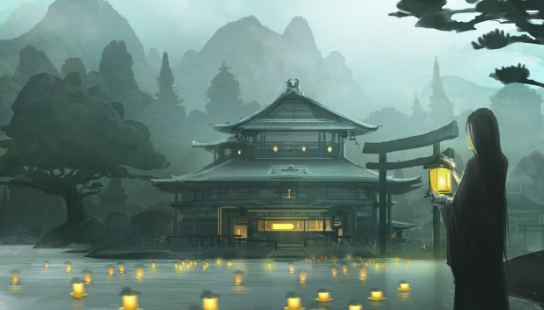
Source: LandWithoutWords/ YouTube
During the Cultural Revolution, Chairman Mao Zedong asked supporters to attack middle-class cultural institutions, seize property, and bring down educational systems. Many believe that it was during this time the statue was taken from the country.
The Story Continues
In 1996, a private owner contacted someone to fix the cracks and chips on the statue’s exterior. But the restorer found two pillows with Chinese text displayed on them under the statue’s knees. It was when he took the pillows off that he discovered the mummy.
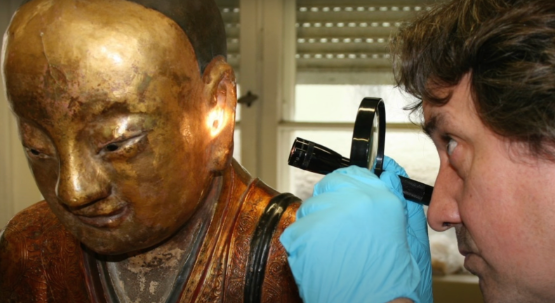
Source: b60/ YouTube
According to Van Vilsteren, “He looked right into the bottom of this monk. You can see part of the bones and tissue of his skin.”
Surprise! Surprise!!
Discovering the mummy in a gold-plated statue isn’t the only surprise in this story. Drents Museum at Meander Medical Centre, Amersfoort, Netherlands, received another shocker as they carried out the CT scan and endoscopy of the mummified Buddha.
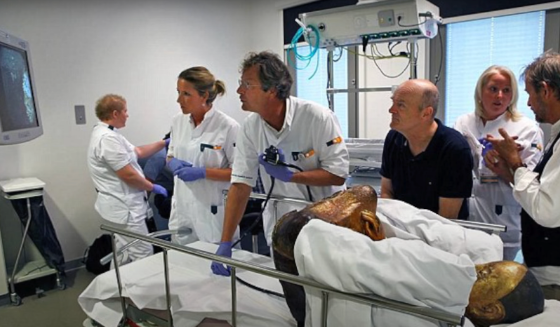
Source: b60/ YouTube
Yes, it was already common knowledge that there was a body inside the statue. But nothing prepared them for the discovery that the organs were removed before the mummification. It’s important to mention that the mummy was on exhibit in 2021 at the Drents Museum.
A Follow-Up
The CT scan at Meander Medical Centre was only a follow-up to a previous one. In 2013, researchers took the mummy through a CT Scan at Mannheim University Hospital in Germany to view it in extensive detail. However, it was only at the Meander Medical Centre that tiny paper scraps with Chinese texts were found.
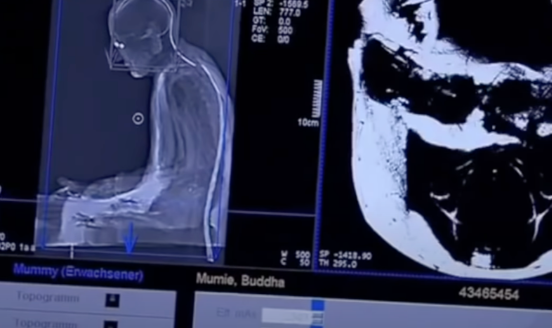
Source: Newsy Science/ YouTube
Fun fact: they once thought the scraps of paper were lung tissues.
A Little About Self-Mummification
The paper scrolls with Chinese writing are one of the pointers that the Buddhists must have undergone self-mummification. While no one knows for sure how Liuquan transformed into a mummy, Van Vilsteren says that self-mummification is a common tradition in Asia, especially in China, Japan, Korea, and Laos.
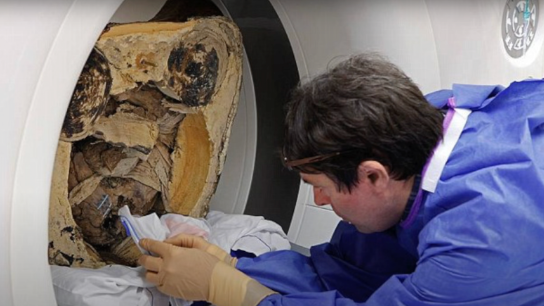
Source: b60/ YouTube
He added, “There are historical records of some aging monks who have done this practice. But if this is also the case with this monk is not known.”
Sokushinbutsu
Self-mummification, called Sokushinbutsu in Japanese, is a process where Buddhist monks avoid all forms of indulgence and observe extreme self-discipline to a deadly point. In Sokushinbutsu, the monks will enter mummification even while they are still breathing. While self-mummification is most popular in Japan, there are also reports of this practice in China and India.
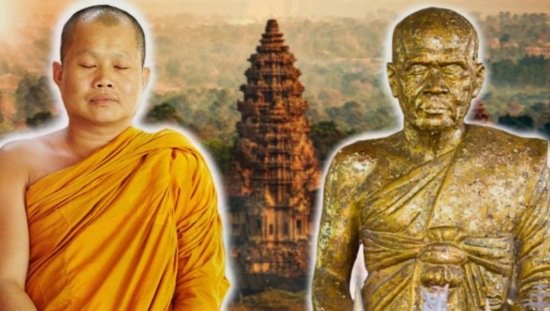
Source: Source: Wiki4All/ YouTube
The process of self-mummification is horrifying, very painful, and not for the faint-hearted.
The Process
Some Buddhists see self-mummification as the highest form of religious enlightenment and reserved it for the most devout monks. To enter a state of self-mummification, the monks had to pass through a long meditative process to attain enlightenment. This involved avoiding grains and other major meals while sticking to a strict diet of nuts, berries, water, etc.
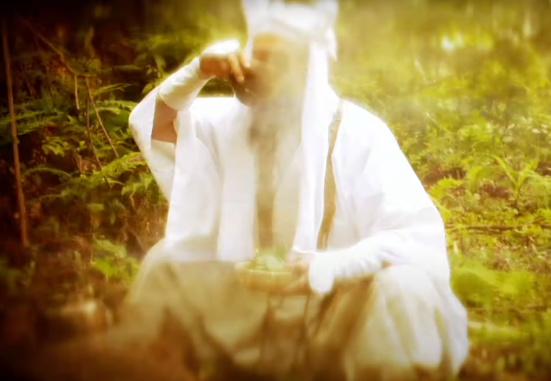
Source: Discovery UK/ YouTube
The monks will undergo this process for a year, after which they’ll enter a statue to be sealed.
More on the Process
After entering the statue, the monks will be fed a special tea from a toxic lacquer tree (Urushi). The monks only had a tube that they used to eat and receive air. They also had a bell placed on them to notify people that they were still alive.
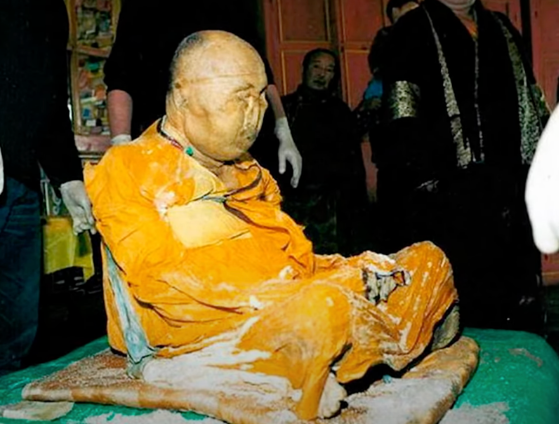
Source: Beyond Science/ YouTube
The monks will remain sealed in a tomb for about 3 years if the bell stops ringing. Usually, they’ll open the tomb again at the end of the 3 years to find the deceased monk intact.
The State of True Enlightenment
If the monk was found in one piece when the tomb was reopened, they had reached true enlightenment. However, if the deceased monk decomposed like every other dead body, their aim of reaching true enlightenment failed.
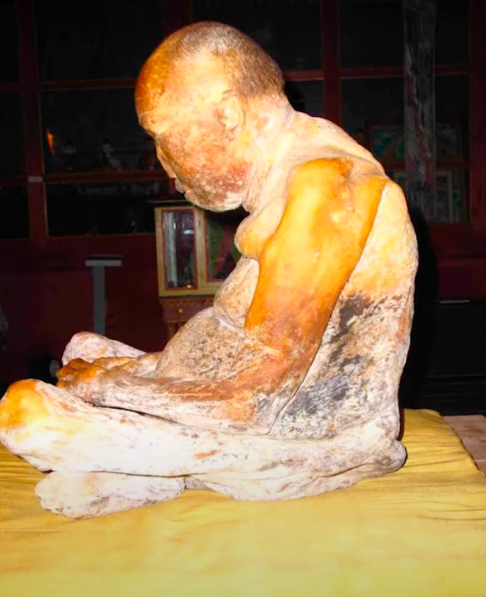
Source: Beyond Science/ YouTube
However, this doesn’t mean that their efforts had gone to waste. Instead, they were still honored for their effort in undergoing this process in the first place. It’s the thought that counts, right?
The Significance of an Incorrupt Body
The practice of honoring a Monk’s intact, self-mummified body comes from the Buddhist belief that an incorrupt body signifies holiness. This is similar to the beliefs held by Eastern Orthodox religions and Roman Catholics. However, the Buddhists went a step further to place the incorrupt mummified corpses in a temple where followers adorned and tended to them.
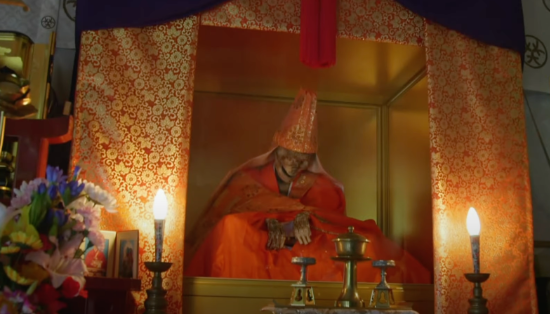
Source: Discovery UK/ YouTube
For decayed bodies, the corpse remained in the tomb which will be resealed. Even though the monk’s efforts were respected, their bodies wouldn’t be revered as holy relics.
A Well Thought Out Process
It’s important to note that every action during self-mummification serves an important purpose. For example, the poisonous tea from an Urushi tree sap was to make the monks too toxic for maggots to eat. Their strict nut, seed, and berry diet (barks and roots were eaten later) were to strip their body of fat.
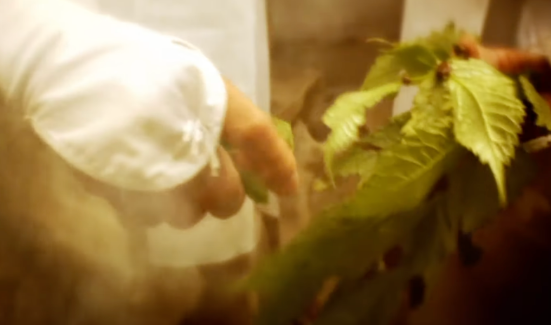
Source: Source: Discovery UK/ YouTube
The monks’ diet also made them lose fluid quickly by inducing vomiting. It helped to preserve their bodies and prevent decay when they died.
A Rift
Liuquan’s full name is Liuquan Zhanggong and was believed to have died around 1100 AD. The statue where he was found became the subject of a disagreement between China and the Netherlands.
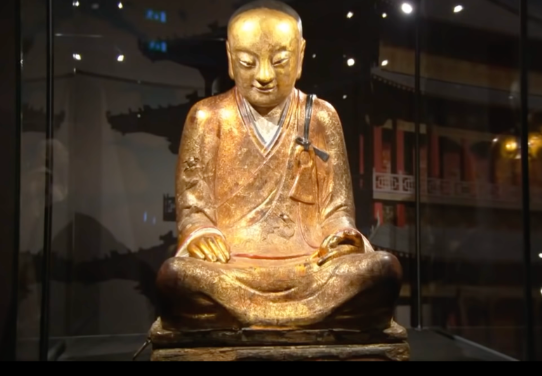
Source: Newsy Science/ YouTube
According to tests, a Dutch antique collector stole it from China 20 years before. As such, East China Community leaders from Yangchun Village requested its return to its original home.
A Revelation and a Puzzle
According to a study, Liuquan Zhanggong was 37 years old at the time of death. From his body, it’s clear that there are two possible causes of death—a disease or prolonged abstinence periods.
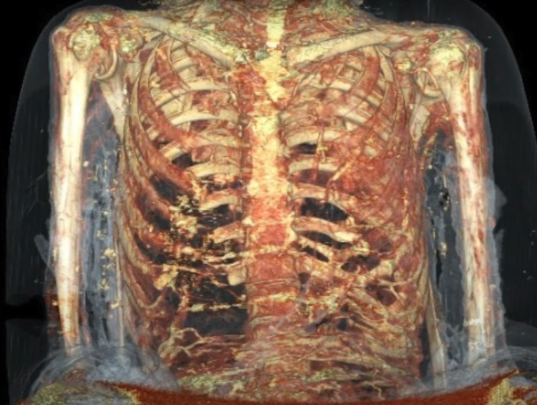
Source: b60/ YouTube
Again, there’s a question of whether he truly underwent self-mummification as the process doesn’t involve organ removal. However, in Liuquan Zhanggong’s case, his organs were missing and replaced with scrolls. It’s unclear how that happened.
Another Mummified Monk
You should have already guessed by now that this wouldn’t be the only mummy found in a Buddha statue. And you’re right! Researchers also found a 200-year-old mummy in Mongolia not so long ago.
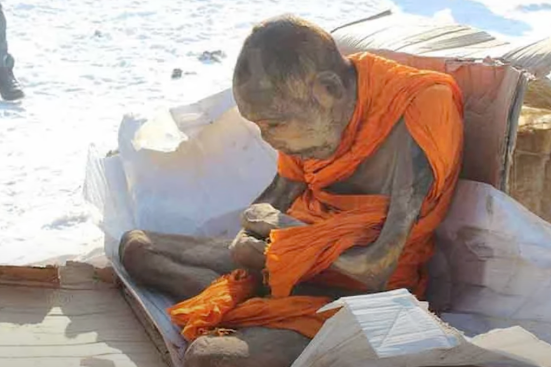
Source: Beyond Science/ YouTube
The mummy was in the lotus position when it was found and had been preserved using cattle skin. According to an expert, it wasn’t dead. It was only in a rare meditative state called “tukdam,” and just a step away from becoming a Buddha.
Here's a Twist to the Story
According to the police, the 200-year-old mummy was stolen from a cave in another part of the country by someone who wanted to sell it off. An unidentified official said the thief hid it in his Ulaanbaatar home pending when he would leave the Mongolian border to sell it at a very high price.
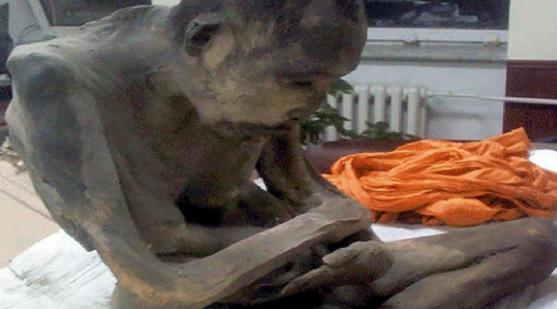
Source: Beyond Science/ YouTube
Smuggling items that are considered cultural heritage is a crime in the country that carries up to 12 years of imprisonment. As such, the man, identified as Enhtor, was quickly arrested.
The Select Few
Out of the hundreds of people that have attempted Sokushinbutsu, only about 30 of them have been successful. Daijuku Bosatsu Shinnyokai-Shonin of the Dainichi-Boo Temple of Japan was one of the most famous and successful ones.

Source: Dark Knight/ Twitter
Daijuku Bosatsu Shinnyokai-Shonin is one of Dainichi-Boo’s main attractions. This mummy used to be a monk in this temple. He was born in 1687 and followed the teaching of Buddha from an early age before he became a Buddha priest. Daijuku Bosatsu Shinnyokai-Shonin now holds the title, “Living Buddha.”
Luang Pho Dang of Thailand
Luang Pho Dang of Thailand is another famous successful mummy who quit his career as a businessman to become a Buddhist monk. He underwent self-mummification in 1972 and died while meditating at 79 years old.
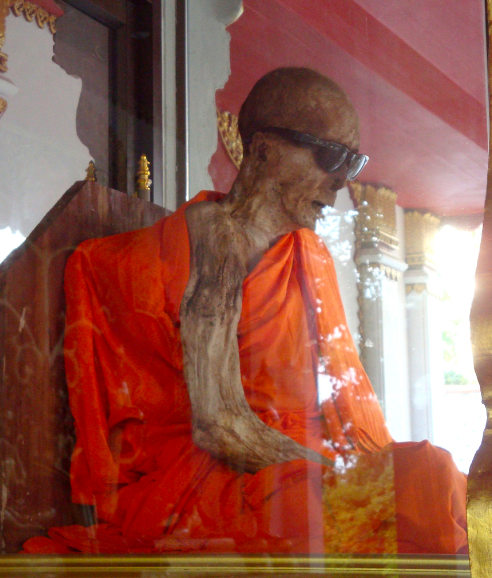
Source: Beyond Science/ YouTube
Luang Pho Dang’s body was placed in a glass coffin in Thailand’s Wat Khunaram on Ko Samui Island Temple in a lotus position. He also had sunglasses placed on his eyes to lessen the dread that children experienced when they saw him.
A Difficult Balance to Strike
Since mummies pass through the same procedures for self-mummification, why are only a few succeed in the act? The answer is pretty simple—successful self-mummification is a difficult nut to crack and requires striking a very challenging balance, especially when the monks were old.
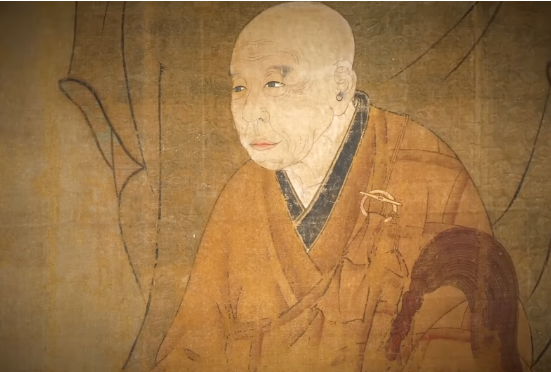
Source: History/ YouTube
Monks who attempt to enter a deep state of meditation (nyūjō) too early will not become dry enough for mummification. As their bodies will rot and they’ll be buried like everyone else. Meanwhile, there’s a high risk of death by starvation or illness if the monks prepared for too long.
To Be Seen Again
Today, anyone who visits some Buddhist Temples will find remains of mummified monks in them. Buddhist believe that these monks have cheated death and will return many years from now.
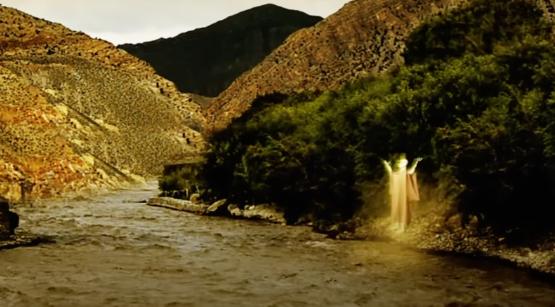
Source: History/ YouTube
According to the story, their coming to this mortal realm will be to guide those deserving of it into nirvana, a state of happiness and liberation. This is expected to happen in about 5.67 million years since their self-mummification.
Little-Known Facts
Self-mummification isn’t the only strange practice in Buddha and there are many lesser-known facts surrounding this religion. For example, Buddhists have different sects, and the popular Dalai Lama heads just one of them—Tibetan Buddhism. This Buddhist sect is different from the ones practiced in South Asia, South Eastern Asia, Japan, and China.
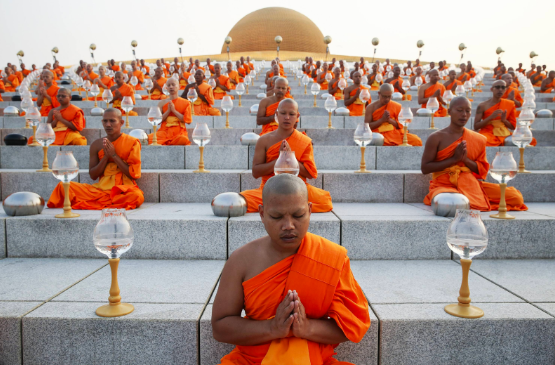
Source: MonsoonValleyUK/ Twitter
Some people also believe one of the criteria for me to become a monk is that they must never have had leprosy, goiter, asthma, boils, scabs, and many other ailments.
What About the Females?
Women, including female spirits and deities, only occupy secondary positions in many Buddhist traditions. The only female deity who has managed to play a significant role among the Theravadins (a Buddhist sect), is goddess Pattini.

Source: DW News/ Twitter
Some people believe that it’s better to be a male than a female in Buddhism as it’s more difficult for females to reach enlightenment compared to males. No Dalai Lama has been a female, and have you ever heard of a female Buddhist mummy?
A Nice Trip to the Hungarian Natural History Museum
The ancient gold-plated Buddha statue is now sitting pretty and on display at the Hungarian Natural History Museum. This museum dates back to 1802 and houses the region’s largest collections of natural history.

Source: AVICOM/ Twitter
Meanwhile, researchers are still putting all the papers from the mummy together. Are you eager to know what the Chinese texts say? We are too! Till then, let’s keep our fingers crossed.
